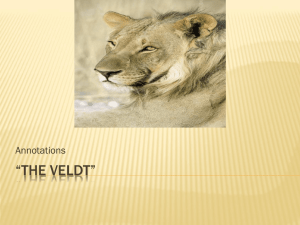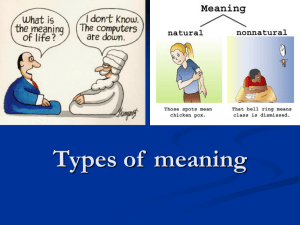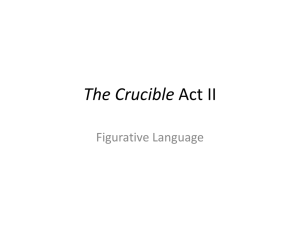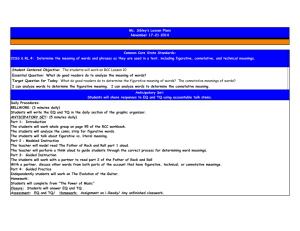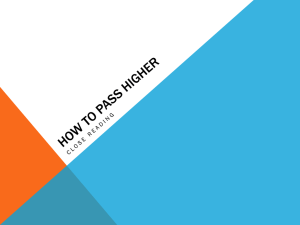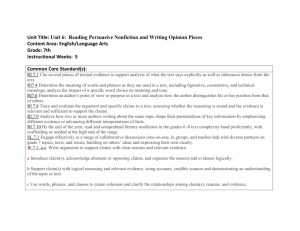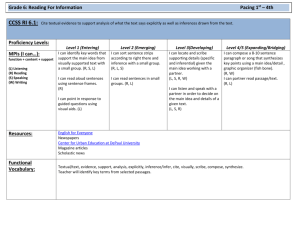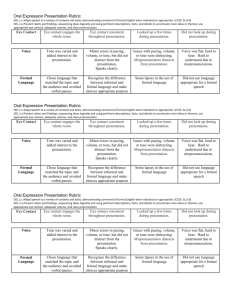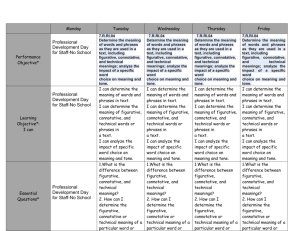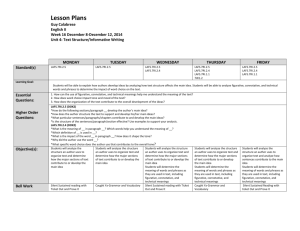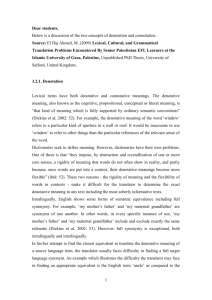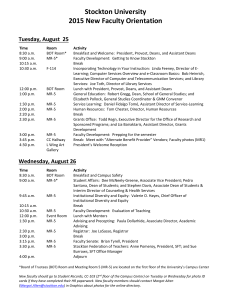I can…
advertisement
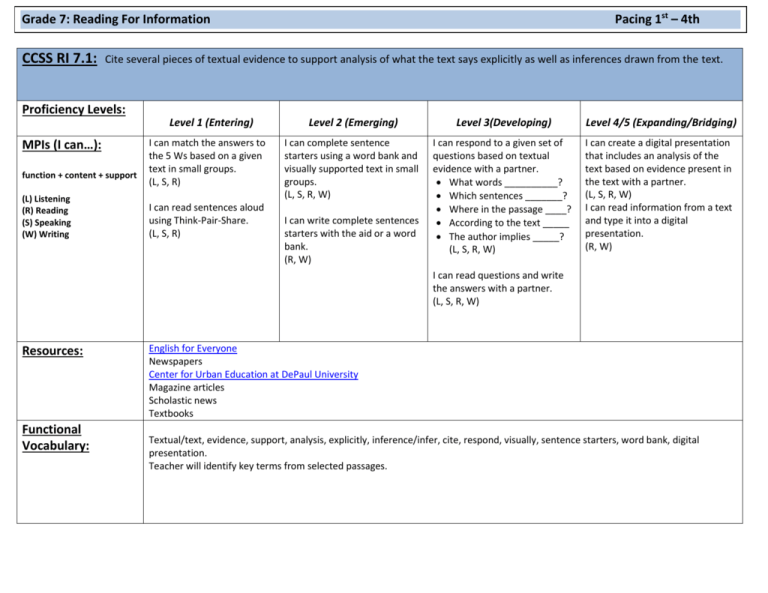
Pacing 1st – 4th Grade 7: Reading For Information CCSS RI 7.1: Cite several pieces of textual evidence to support analysis of what the text says explicitly as well as inferences drawn from the text. Proficiency Levels: Level 1 (Entering) MPIs (I can…): function + content + support (L) Listening (R) Reading (S) Speaking (W) Writing I can match the answers to the 5 Ws based on a given text in small groups. (L, S, R) I can read sentences aloud using Think-Pair-Share. (L, S, R) Level 2 (Emerging) Level 3(Developing) Level 4/5 (Expanding/Bridging) I can complete sentence starters using a word bank and visually supported text in small groups. (L, S, R, W) I can respond to a given set of questions based on textual evidence with a partner. What words __________? Which sentences _______? Where in the passage ____? According to the text _____ The author implies _____? (L, S, R, W) I can create a digital presentation that includes an analysis of the text based on evidence present in the text with a partner. (L, S, R, W) I can read information from a text and type it into a digital presentation. (R, W) I can write complete sentences starters with the aid or a word bank. (R, W) I can read questions and write the answers with a partner. (L, S, R, W) Resources: Functional Vocabulary: English for Everyone Newspapers Center for Urban Education at DePaul University Magazine articles Scholastic news Textbooks Textual/text, evidence, support, analysis, explicitly, inference/infer, cite, respond, visually, sentence starters, word bank, digital presentation. Teacher will identify key terms from selected passages. Pacing 1st – 4th Grade 7: Reading For Information CCSS: RI 7.2: Determine two or more central ideas in a text and analyze their development over the course of the text; provide an objective summary of the text. Proficiency Levels: MPIs (I can…): function + content + support (L) Listening (R) Reading (S) Speaking (W) Writing Level 1 (Entering) Level 2 (Emerging) Level 3(Developing) Level 4/5 (Expanding/Bridging) I can sort labeled and illustrated details onto a tchart about a passage with a partner. (L, S, R) I can conclude two central ideas from a passage using a tchart by taking notes with a partner. (L, S, R, W) I can conclude two central ideas from a passage using a T-chart with a partner. (L, S, R, W) I can conclude two central ideas from a passage using a T-chart with a partner. (L, S, R, W) I can build sentences from the t-chart with a partner. (L, S, R, W) I can present the t-chart to the group. (L, S, R) I can explain the doublebubble map using paragraph frames. (S, R) I can objectively summarize a passage using the T-chart with a partner. (L, S, R) I can read the sentences with a partner. (L, S) Resources: Texts: Center for Urban Education Brainpop: Summarizing Smart Exchange: Summarizing Youtube: Main Idea video by Learningupgrade.com Functional Vocabulary: Determine central idea/theme/main idea analyze course of the text, text/textual objective summary/summarize/sum conclude/conclusion/draws a conclusion I can compose a two or more paragraph summary using complete sentences and transition/signal words based on previously completed T-chart. (R, W) Teachers will identify key terms from selected passages. Pacing 1st – 4th Grade 7: Reading For Information CCSS: RI 7.3: Analyze the interactions between individuals, events, and ideas in a text (e.g., how ideas influence individuals or events, or how individuals influence ideas or events). Proficiency Levels: MPIs (I can…): function + content + support Level 1 (Entering) Level 2 (Emerging) Level 3(Developing) Level 4/5 (Expanding/Bridging) I can relate individuals to events with the aid of visual supports and leveled texts with a partner. (l, s, r) I can establish the relationship between events and decisions made by leaders using manipulatives and given events. (r, l, s, w) I can judge and critique the decisions of leaders using a cause/effect graphic organizer with my partner. (r, w) I can forecast how current events will impact the way history will be written in the future working with a small group. (l, s, r, w) (L) Listening (R) Reading (S) Speaking (W) Writing I can reflect the validity of a leader’s decision using a published product based on a partially completed graphic organizer. (r, w) I can compose a chapter of a history book for future generations with my group using current events.(l, s, r, w) Resources: Newspapers Leveled texts Dogonews.com Picture of leaders Sks.sirs.com Library of Congress for Kids Functional Vocabulary: Judge, Critique, Reflect, Validity, Published product, Partially, Forecast, Current Events, Impact, Compose, Generations, Establish, Relationship, Events, Manipulatives, Relayed, Partially Pacing 1st – 4th Grade 7: Reading For Information CCSS: RI 7.4: Determine the meaning of words and phrases as they are used in a text, including figurative, connotative, and technical meanings; analyze the impact of a specific word choice on meaning and tone. Proficiency Levels: Level 1 (Entering) MPIs (I can…): function + content + support I can match illustrations of figurative language to its illustrated meanings with a partner. (S,L,) I can match labels to facial expressions to explore the tone of a text with my partner.(R,S,L) I can match illustrations of connotative and denotative meanings with a partner (S,L) I can match illustrations of technical language with its label with a partner. (R,S,L) Level 2 (Emerging) I can illustrate figurative language examples with my group using a T Chart.(L,S,R) I can illustrate technical language examples with my group using a T Chart.(L,S,R) I can illustrate how certain words impacted the tone of a text with my group using a T Chart.(L,S, R) Level 3(Developing) I can create a flip book of figurative language forms with my group finding examples from a text.(L,S,R,W) Level 4/5 (Expanding/Bridging) I can complete a T Chart to defend my understanding of figurative language with my group using a text. (L,S,R,W) I can create a flipbook of technical language using nonfiction text.(L,S,R,W) I can complete a T Chart to defend my understanding of connotative versus denotative language using a text.(L,S,R,W) I can create a flipbook of how specific words in a text impact tone.(L,S,R,W) I can complete a T Chart to defend my understanding of technical language using a text.(L,S,R,W) I can complete a T Chart to defend my understanding the impact of a specific word on meaning and tone using a text.(L,S,R,W) Grade 7: Reading For Information Resources: http://www.sturgeon.k12.mo.us/elementary/numphrey/subjectpages/languagearts/figuresofspeech.html http://www.vrml.k12.la.us/8th/homework/read/8units/unit1_hum.htm http://www.vocabulary.co.il/connotative_denotative_vocabulary/ http://prezi.com/r0rrlpodtbvu/figurative-and-connotative-language/ All the Parts by Tedd Arnold (figurative language) Science texts Functional Vocabulary: Defend Connotative Denotative Figurative Tone Impact Facial expression Technical language Label Pacing 1st – 4th
